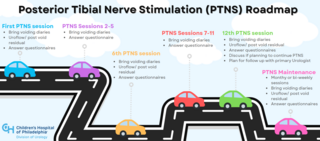Neuromodulation Therapies
The NEBULA Program offers a range of neuromodulation therapies to patients with complex bowel and bladder disorders at Children’s Hospital of Philadelphia.
Para sacral TENS (pTENS)
Para sacral transcutaneous electrical nerve stimulation (pTENS) is a form of neuromodulation that uses low-voltage electrical currents to deliver nerve simulation via a topical electrode through the skin. This therapy has been shown to improve lower urinary tract dysfunction in some studies. While devices and device-setting vary among different studies, this treatment option is minimally invasive, can be performed at home, and has few, if any, side effects. Despite these benefits, pTENS may be less effective than other forms of neuromodulation.
Posterior tibial nerve stimulation (PTNS)

Posterior tibial nerve stimulation (PTNS) is an alternative therapy that uses a very fine needle, like an acupuncture needle, in the ankle area to stimulate the nerve that goes to the same area of the spine that supplies the bowel and bladder. This can help improve patients’ bladder sensation and help patients stay drier. PTNS requires 12 weekly visits for 30-minute sessions, followed by maintenance therapies, which will be determined by your provider.
Translumbosacral anorectal magnetic stimulation (TAMS) and translumbosacral neuromodulation therapy (TNT)
Translumbosacral anorectal magnetic stimulation (TAMS) and translumbosacral neuromodulation therapy (TNT) are noninvasive, novel therapies for children to help improve fecal incontinence.
TAMS testing is used to measure anorectal neuropathy in children with anorectal disorders presenting with fecal incontinence. The test involves magnetic stimulation at the lumbar/sacral level. More specifically, it is a minimally invasive magnetic stimulation of the lumbar and sacral nerve plexus that records the anal and rectal moto-evoked potentials (MEPS). There are four locations in the lumbosacral region that are assessed with magnetic coils.
TNT is used as a treatment for anorectal neuropathy to improve fecal incontinence. It provides a repetitive stimulus using magnetic coils in the same four locations that were assessed during the TAMS procedure. This therapy is done weekly for 6 weeks.
Sacral nerve stimulation
Sacral nerve stimulation is an option for neuromodulation that is growing in use. This requires placement of a nerve stimulator in the lower part of back, along the lower spine. This type of neuromodulation uses gentle stimulation to target the communication between the brain, bowel and bladder. This device is FDA-approved for overactive bladders, non-obstructive urinary retention and encopresis. In adult use, research has shown improvement in bowel and bladder continence following placement of the sacral nerve stimulation.
Placement of a sacral nerve stimulator is performed in two parts. Phase 1 is a trial period, where a lead is implanted in the operating room and a stimulator is connected outside the body. Patients are asked to complete a diary to assess symptom improvement. If the trial period results in improvement of symptoms, following discussion with our team, a permanent device will be implanted.